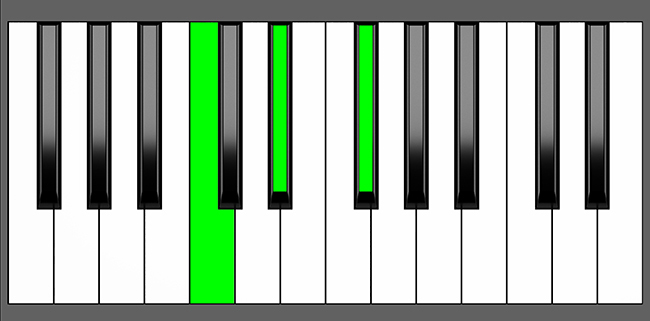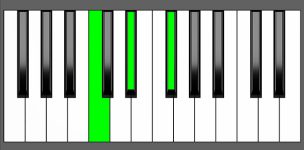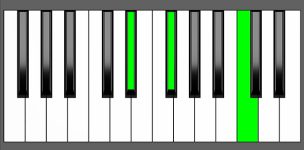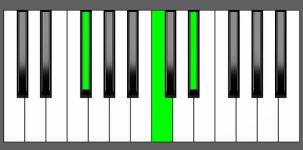Piano Diagram of C dim in Root Position

The C dim chord is the diminished triad built upon the C key. It is built by combining the Root note (C), the minor 3rd (Eb), and the diminished 5th (Gb) notes from the C scale. Keep reading to learn more about the music theory behind this chord.
Structure of C dim
Notes |
|---|
| C, Eb, Gb |
Intervals |
|---|
| R, m3, d5 |
Fingers Position
Left Hand |
|---|
| 4, 2, 1
5, 3, 1 |
Right Hand |
|---|
| 1, 2, 4
1, 3, 5 |
C dim Chord Inversions
The C dim chord has a total of 2 inversions:
| Root Position: | C | Eb | Gb |
| 1st Inversion: | Eb | Gb | C |
| 2nd Inversion: | Gb | C | Eb |
Piano Keyboard Diagrams
Music Theory and Harmony of C diminished
What are Diminished Chords?
In music theory, diminished chords are classified as triads just like major, minor, and augmented chords. A diminished triad is a chord that has a root note, a minor 3rd, and a diminished 5th. They are often abbreviated with a small circle (°) or the letters “dim”. For example, an A diminished chord would be written as A° or Adim.
The interval between the root and the diminished 5th is called a “tritone” and creates a dissonant sound that adds tension and instability. Diminished triads are commonly used as transitional chords, leading to more stable chords.
Different types of Diminished Chords
- Diminished triads are usually considered unstable and are often used as transitional chords that create tension and lead to a more stable chord.
- There are also diminished seventh chords, which include an added diminished seventh interval above the root note. These chords are often written as °7 or dim7. They can also be used as a substitute for dominant 7th chords.
- Additionally, there are half-diminished chords (also known as minor seventh flat five chords), which include a minor seventh interval instead of a diminished seventh.
But for now, let’s explore the simpler diminished triad in the key of C.
Building the C dim Chord: Different Approaches
Starting from a Major Scale
To build a diminished chord, you begin by selecting the root note, the 3rd note, and the 5th note of the major scale. Next, you lower the 3rd and the 5th note by one half-step.

So, if you want to build a C diminished chord, you would start with the C major chord, which consists of the notes C, E, and G. Then, you would lower the third note, E, by one half-step to get Eb and lower the fifth note, G, by one more half-step to get Gb. The resulting notes, C, Eb, and Gb form the C diminished chord.
by Combining 3rds
Alternatively, a diminished chord can be built by stacking two minor 3rd intervals on top of each other. To get this chord, you begin with the root note and then raise it by a minor 3rd. Next, you raise the third note by another minor 3rd. The resulting chord will consist of three notes that are spaced an equal distance apart.
m3 + m3 = diminished Chords
To form a C dim chord, you start with the root note C and raise it by a minor 3rd to Eb. Then, you raise the third note Eb by another minor 3rd to Gb. This results in a C dim chord consisting of the notes C, Eb, and Gb.
How to Use C dim in a Chord Progression
Harmonic functions describe how chords sound together in a specific key and context. In Western music, there are seven main harmonic functions, one for each note of the diatonic scale. Major chords are represented by capitalized Roman numerals, while minor chords are represented by lowercase ones.
The tables below show the Bb minor scale and its relative major scale, both of which include a C diminished chord. The C diminished chord is found on the second scale degree (II) in the Bb minor scale and on the seventh scale degree (VII) in the D-flat major scale. However, for a more comprehensive list of its uses, please refer to the dim7 tables, where I delve deeper into some of the features of these chords.
on Natural minor Scale
| Minor Scale | i | ii | III | iv | v | VI | VII |
|---|---|---|---|---|---|---|---|
| Bb | Bb min | C dim | Db Maj | Eb min | F min | Gb Maj | Ab Maj |
- Supertonic chord in Bb minor
on Major Scale
| Major Scale | I | ii | iii | IV | V | vi | vii |
|---|---|---|---|---|---|---|---|
| Db | Db Maj | Eb min | F min | Gb Maj | Ab Maj | Bb min | C dim |
- Leading tone chord in Db Major
C dim Chord Function in Major and Minor Keys
Understanding Scale Degrees
When we create chords from a scale, each note in the scale is given a specific degree that reflects its position in the scale. In the diatonic major scale, there are seven degrees, and each degree plays a unique role in the overall harmony of the scale.
- The first degree of the scale is called the Tonic, and it’s like the home base of the music. It provides a stable tonal center that serves as the foundation for the scale.
- The second degree of the scale is called the Supertonic. It’s often used as a transitional note between the tonic and other notes in the scale.
- The third degree of the scale is called the Mediant. It’s located halfway between the tonic and dominant notes and helps to establish whether the scale is major or minor.
- The fourth degree of the scale is called the Subdominant. It’s often used as a complementary harmony to the dominant.
- The fifth degree of the scale is called the Dominant. It generates tension and a sense of expectation, and it’s usually resolved by returning to the tonic.
- The sixth degree of the scale is called the Submediant. It’s often used as a transition between the dominant and tonic, and it provides a sense of stability and restfulness to the music.
- The seventh degree of the scale is called the Leading tone. It’s located one half step below the tonic and produces a strong sense of tension and a desire to resolve to the first degree.
C dim in Bb Minor
In the key of Bb minor, the C diminished chord serves as the supertonic chord, which is the chord built on the second degree of the scale. It is often used as a passing chord to create movement between other chords in a progression.
| i | ii | III | iv | v | VI | VII |
| Bb min | C dim | Db Maj | Eb min | F min | Gb Maj | Ab Maj |
C dim Chord Progressions as ii degree
Here are some examples of chord progressions that feature the C diminished as the supertonic chord.
ii iv V i
| ii | iv | V | i |
| C dim | Eb min | F Maj | Bb min |
In minor keys, the fifth degree (v) is often replaced with a dominant 7th chord (V7) or a major chord (V) in the context of triads. This chord is derived from the harmonic minor scale and is commonly used in this position.
iv ii i
| iv | ii | i |
| Eb min | C dim | Bb min |
VII ii i
| VII | ii | i |
| Ab Maj | C dim | Bb min |
ii V i
| ii | V | i |
| C dim | F Maj | Bb min |
C dim in Db Major
In the key of D-flat major, the C diminished chord serves as the leading tone chord, which is built on the seventh degree of the scale. The leading tone chord is often used to create a sense of tension and resolution as it strongly pulls towards the tonic chord, which is the Db major chord in this case.
| I | ii | iii | IV | V | vi | vii |
| Db Maj | Eb min | F min | Gb Maj | Ab Maj | Bb min | C dim |
C dim Chord Progressions as vii degree
The following chord progressions feature the C dim chord as the leading tone:
V vii I
| V | vii | I |
| Ab Maj | C dim | Db Maj |
I IV vii iii vi ii V I
| I | IV | vii | iii | vi | ii | V | I |
| Db Maj | Gb Maj | C dim | F min | Bb min | Eb min | Ab Maj | Db Maj |
Alternative Names for C Diminished
- C°
- Cdim
- C diminished


